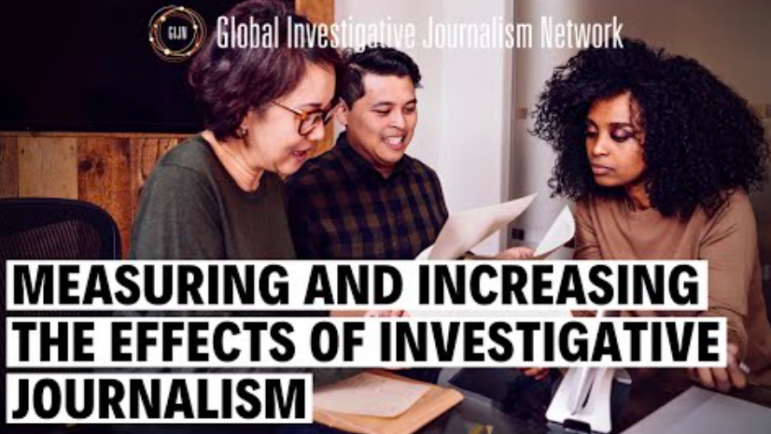

Tips to Amplify Investigative Impact
Read this article in
Too often, newsrooms will publish an accountability scoop, and then simply hope that the right legislators, law enforcement officials, or community activists stumble upon it in time, and act to remedy the issue revealed in the story.
But impact experts say there are several ways to help direct the attention of change-makers — as well as other media — to your key findings, and even nudge them to action. In a recent GIJN webinar on “Measuring and Increasing the Effect of Investigative Journalism,” a panel of three editors and an impact strategist shared tips like these:
- Make simple videos of your best text revelations.
- Time story publication to moments ripe for change.
- Cross-promote with collaborative partners.
- Tag key officials on social media, and amplify with audience groups.
- Consider free tools to track and display your real-world impact.
- “Bang the drum” with community-focused follow-ups.
- Keep seeking comment from officials — even if you don’t need the quotes.
The panel featured Grace Murray, acting impact editor at The Bureau of Investigative Journalism (TBIJ); Wahyu Dhyatmika, CEO of Indonesia’s Info Media Digital; Lindsay Green-Barber, founder of Impact Architects; and Anya Schiffrin, editor of the watchdog history book “Global Muckraking.”
“As we all know, watchdog reporting makes a critical contribution to society by exposing wrongdoing, fighting corruption, and promoting accountability — but how do we measure this, and how do we explain to a skeptical public the value of investigative reporting?” asked Schiffrin — who is also director of the Technology, Media, and Communications program at Columbia University. “Impact can be obvious, such as when a government official resigns, or a company’s stock price collapses; it can be measured in metrics, like dollars saved, or assets seized, or policy reforms passed. But it’s not always obvious.”
Green-Barber said impact could involve “any change from the status quo” resulting from a story, while Murray added that potential impact can be estimated by the annoying “So what?” question during the brainstorm or story selection phase of an investigation.
For instance: the revelation that a corporate executive may be in violation of a law that prohibits ex-felons from holding executive roles in public companies might scoop rival business beat writers, but would be unlikely to move audiences or policymakers — who might wonder why it’s relevant. By contrast, an investigation that ends a smear campaign against a courageous prosecutor — as journalists did when exonerating a South African attorney general — can have significant impact for accountability, and also build public trust for journalism.
“It’s worthwhile thinking of what kind of impact you’re likely to have, what difference could this story make, what systemic issues could our investigation address?” said Murray. “Be that annoying person who asks: ‘Why are we doing this? Hasn’t that been over-reported? Will this really move the needle?’”
Setting Impact Goals
After gathering data on the little-known role that the market for collagen has on global deforestation, the team at TBIJ realized that this protein’s positive association with wellness fads, along with the counterintuitive nature of their findings, could limit the impact of their story.
So — in their story-angling and social media promotion — the TBIJ team set an impact goal of associating “collagen” with other well-known deforestation trigger terms like timber, beef, soy, and gold in public discussions of the environmental crisis.
“We really wanted to put collagen on the map when talking about commodities and deforestation — and we’ve seen that beginning,” explained Murray. “When we sent our right-of-replies to the companies ahead of publication, we were able to see a memo from a company that instructed their suppliers that they were ending sourcing from the Amazon region immediately.”
The collagen story points to another important tip about goal-setting: the quickest and most decisive investigative impacts often follow revelations of harm that companies or government agencies were genuinely unaware of, and which either horrify them or threaten their brand. For instance, New York Times visual investigations reporter Malachy Browne has told GIJN how a police department in the US state of Kentucky didn’t know that “non-lethal” pepper ball projectiles used for crowd control could lead to lethal outcomes. As a result of his investigation of the killing of restaurant owner David McAtee, the department reviewed its policy on use of these weapons.
Similarly, major retailers will likely pull toys from their shelves if you get simple lab test results that show the paint used on the toys has toxic levels of lead. This example points to yet another impact tip from Murray: that choosing more emotive story angles “that generate real feelings” can lead to impact on broader problems. You could choose to test for lead in paint on the walls of tech company offices — but you are far more likely to generate a recall or policy impact if, instead, you test paint on children’s toys.
Techniques to Amplify Core Findings
Above all, Murray and Green-Barber stressed that investigative newsrooms need to develop a “culture of impact,” in which change-making potential and outcomes are considered by all editorial staff at every stage, from brainstorming and story content to social media strategy and follow-up interviews.
“If you’re able to track and measure impact, you can fundraise, you can build your organization, and build trust,” said Green-Barber. “Journalists used to say, ‘This isn’t our job,’ but many have learned that it makes them more effective in their craft. Have it be part of the work expectation, down to the reporters — maybe you have a once-a-month block of 10 minutes in your editorial meeting to enter impacts.”
For newsrooms with limited budgets and time, Murray suggested four editorial strategies for added impact.
- Keep sending emails with “seeking your comment” in the subject line — if only to get officials to learn your findings right away. “Asking people for a comment gets it read faster than just a message to say ‘we have this story out today’,” said Murray. “Do send the story to everyone you worked with on the project. But I want to underline that asking people to comment on your story — be that NGOs, politicians, industry bodies, etc — can definitely generate a day-two or day-three story.”
- Brainstorm follow-up stories, and keep them coming for months. “For our recent collagen investigation we had a five day content plan, where we had a follow-up reactions piece, a spotlight on Indigenous peoples piece, a first-person newsletter, and the communication of different assets on social media — two videos and an animation,” Murray explained. “You have to keep banging the drum.”
- Offer clear takeaways of your core findings in the content. “Establishing key messages is really crucial,” Murray added. “What three things do you want people to come away from your story with?”
- Mobilize your findings on social media with strategic tagging, group discussions — and even short video clips of the reporter summarizing the findings. ”Social media is a key, cheap tool for getting your story out there, and it’s important to tag the people who you want to see your story,” Murray said. “And don’t underestimate you, the reporter, just telling people what your story is, into the camera. That’s compelling, and if you use a grabby opening question — like ‘Do you know how hacking really works?’ — that can pique people’s interest.”
As GIJN Social Media and Engagement Editor Holly Pate recently pointed out, an outstanding local story on the web of lies behind a candidate for US Congress failed to challenge that man’s election, partly because the small newsroom did little to promote its powerful revelations on social media. (And, of course, because major media missed the story till after the election.)
Dhyatmika — a former executive editor of Indonesia’s independent Tempo Magazine – said quantitative analytics tools that measure users, reach, and engagement are useful, but that other means are needed to measure real-world changes.
He said Tempo actively searches for, and reports on, downstream impact from stories, and interacts with reader groups to deepen change, and reach people beyond the magazine’s core audience.
“We use different social media platforms to trigger dialogue between readers and the newsroom,” said Dhyatmika. “We need to track everything from small letters from audiences saying they were moved, to a call from law enforcement agencies wanting to know more, or an invitation to attend a hearing in parliament. We publish about those responses, and we keep the story rolling online.”
Green-Barber described a free, customizable tool from her firm Impact Architects — the Impact Tracker — that can generate trends and visualizations of story-generated change, based on data inputs by editorial staff.
“We have ‘sparking change’ as part of our logo, and this word ‘sparking’ is crucial, because we are journalists exposing wrongdoing, and holding people accountable, but we are not the people bringing about change ourselves,” said Murray. “We want to provide the evidence that other people can use.”
Watch the full GIJN webinar below:
Additional Resources
Mastering the Rollout: Increasing the Impact of Your Investigative Story
GIJN Resource Center — Impact: Essential Reading
 Rowan Philp is a reporter for GIJN. He was formerly chief reporter for South Africa’s Sunday Times. As a foreign correspondent, he has reported on news, politics, corruption, and conflict from more than two dozen countries around the world.
Rowan Philp is a reporter for GIJN. He was formerly chief reporter for South Africa’s Sunday Times. As a foreign correspondent, he has reported on news, politics, corruption, and conflict from more than two dozen countries around the world.










